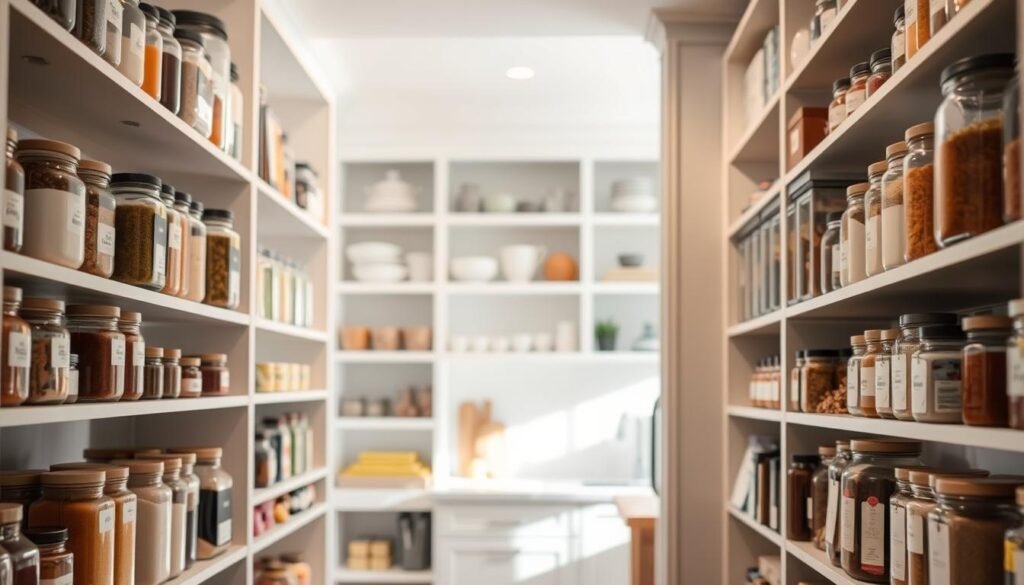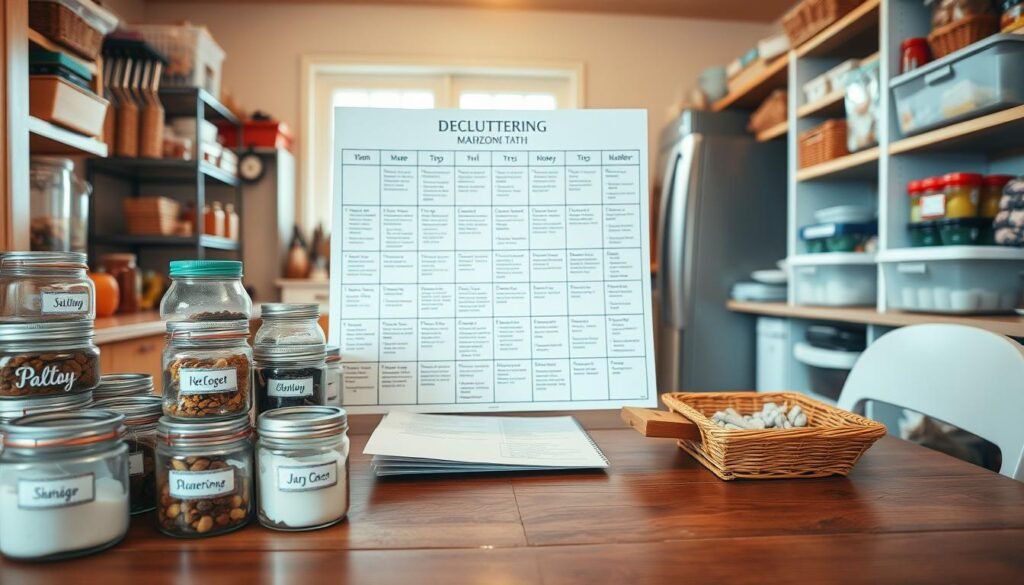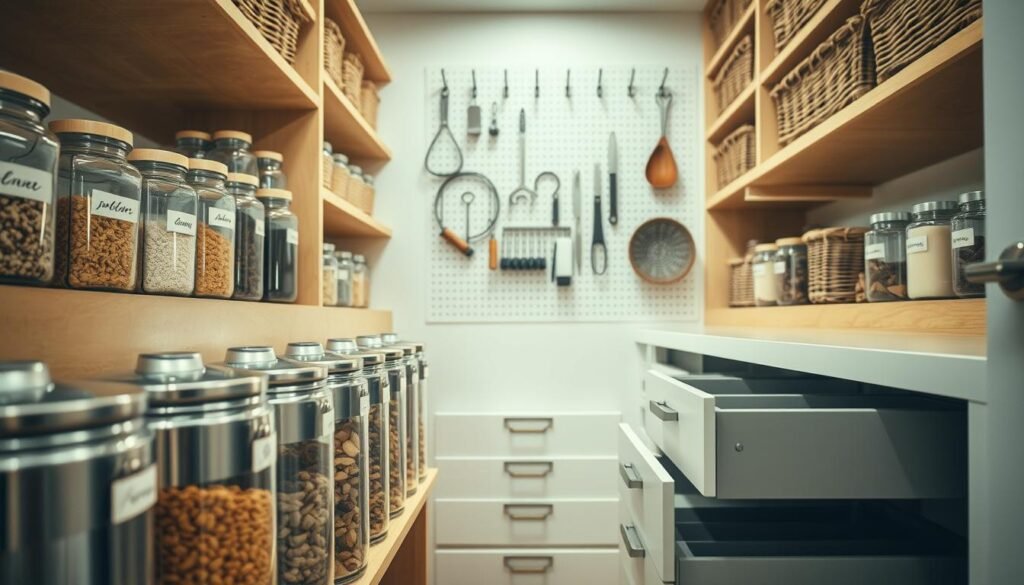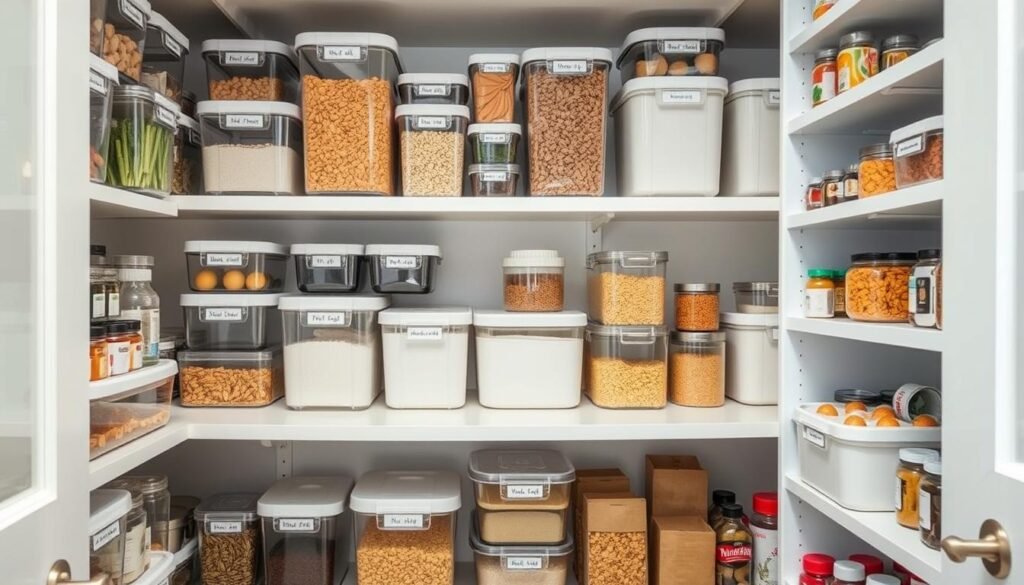
Are you tired of feeling overwhelmed every time you open your pantry doors? You’re not alone! A cluttered kitchen space can make meal preparation stressful and time-consuming. The good news is that transforming your pantry from chaotic to organized is easier than you think.
By following simple steps, you can create an organized pantry that not only looks better but also saves you money by preventing food waste and duplicate purchases. We’ll explore how to declutter your kitchen storage without requiring expensive organizing products or professional help.
Key Takeaways
- Simple steps to transform your pantry into an organized space
- How an organized pantry can save you money
- Practical tips for decluttering without expensive products
- The psychology behind pantry clutter and how to address it
- Transforming small pantries with the right decluttering approach
Why Your Pantry Needs Decluttering

A cluttered pantry can significantly impact your cooking experience and overall kitchen efficiency. When your pantry is disorganized, it can lead to frustration and wasted time searching for ingredients.
The Challenge of Kitchen Organization
Organizing your kitchen, particularly the pantry, can be daunting. The chaos of a cluttered pantry can make meal preparation feel like a chore. It’s not just about aesthetics; a disorganized pantry can lead to food waste and increased grocery bills.
Benefits of a Well-Organized Pantry Space
A well-organized pantry space transforms your cooking experience. You’ll save money by preventing duplicate purchases and reducing food waste. An organized pantry makes inventory management effortless, reducing decision fatigue when planning meals. The visual calm of an organized pantry creates a positive ripple effect throughout your kitchen routines.
Preparing to Declutter Your Pantry

To tackle the chaos in your pantry, you need a plan, and it all starts with preparation. Before diving into the decluttering process, it’s crucial to assess your current situation, gather the necessary tools, and allocate sufficient time for the task.
Assessing Your Current Pantry Situation
Start by taking stock of your pantry’s contents. Open those doors and take a good look inside. What do you see? Are there expired items? Are there duplicates? Understanding what’s inside your pantry is the first step towards decluttering it. Take note of the items that are still good, those that are expired, and those that you no longer need.
Gathering Necessary Supplies
Once you have a clear idea of what you’re dealing with, it’s time to gather your supplies. You’ll need some sturdy boxes or bags for disposing of or donating items, cleaning supplies for sanitizing the shelves, and possibly some new storage containers to help keep things organized. Having everything you need at hand will make the decluttering process smoother and more efficient.
Setting Aside Dedicated Time
Decluttering your pantry isn’t a task to be rushed. You’ll need to set aside time to do it properly. Consider your schedule and plan out when you’ll work on your pantry. Breaking the task into smaller sessions can make it more manageable, especially if you have a large pantry or limited time available. Choose a plan that works for you and stick to it.
The Essential Pantry Decluttering Process

Decluttering your pantry can seem daunting, but with a clear process, you’ll be enjoying a more organized kitchen in no time. The key is to tackle the task step by step, ensuring that you don’t feel overwhelmed by the task at hand.
Step 1: Empty and Sort Items by Category
Start by completely emptying your pantry. Yes, you read that right – everything out! Once everything is out, sort items into categories such as grains, canned goods, baking supplies, and snacks. This categorization process makes it easier to see what you have and decide what to keep or discard. By sorting into categories, you’re taking the first step towards a more organized pantry.
Step 2: Purge Expired and Unused Items
With your items sorted, it’s time to get rid of anything that’s expired, spoiled, or simply hasn’t been used in a long time. Be ruthless – if you haven’t used it in the past year, it’s likely safe to get rid of it. This step is crucial in the decluttering process, as it directly impacts the quality and usability of the items you decide to keep in your pantry. Discarding expired or unused food items will make room for what’s truly important.
Step 3: Clean Shelves Before Restocking
Before putting everything back, take the opportunity to thoroughly clean your pantry shelves. Here are some tips to make the most of this step:
- Take advantage of empty shelves to thoroughly clean surfaces that are rarely accessible when the pantry is full.
- Wipe down shelves with an appropriate cleaner for your shelf material – wood, metal, and plastic shelving each have different cleaning requirements.
- Check for any pest issues that might have been hidden behind products and address them before restocking your pantry.
- Consider lining shelves with washable shelf liners to make future cleaning easier and protect surfaces from spills.
- Clean the pantry door, hinges, and handles – these high-touch areas often collect grime that goes unnoticed.
- Allow shelves to dry completely before beginning the restocking process to prevent moisture-related issues with food packaging.
This cleaning step creates a fresh foundation for your newly organized pantry and psychologically marks the transition from old habits to new systems, making it easier to maintain your newly decluttered pantry by sorting items into a specific category.
Creating an Organized Pantry System

Now that you’ve decluttered your pantry, it’s time to create a system that keeps it organized. An effective pantry system is more than just storing food; it’s about creating a space that is functional, efficient, and easy to maintain.
Establishing Functional Zones
Dividing your pantry into functional zones can significantly enhance its usability. Consider categorizing your storage into areas for baking supplies, snacks, canned goods, and condiments. This zoning strategy makes it easier to locate items and prevents clutter from building up in the future.
For instance, you might dedicate a specific shelf to frequently used items, making them easily accessible. By doing so, you’re not only organizing your pantry but also streamlining your cooking process.
Measuring Your Space for Maximum Efficiency
To maximize your pantry’s storage potential, it’s crucial to measure your space accurately. Take note of the dimensions of your shelves, the height of your storage areas, and any obstacles that might affect storage, such as plumbing or electrical outlets.
By understanding your pantry’s layout, you can choose the most appropriate storage solutions, ensuring that every item has its designated place.
Implementing the “One In, One Out” Rule
The “one in, one out” rule is a simple yet effective strategy for maintaining your pantry’s organization. The principle is straightforward: for every new item you bring into your pantry, an old one must be removed.
- This rule helps prevent clutter from accumulating by maintaining a balance between new and existing items.
- It’s particularly useful for categories that tend to multiply, such as condiments and snack foods.
- By adopting this rule, you’ll not only keep your pantry organized but also reduce food waste by ensuring that older items are consumed before they expire.
| Category | Action | Benefit |
|---|---|---|
| Condiments | Remove expired or unused items | Reduced clutter, easier access |
| Snack Foods | Limit new purchases based on existing stock | Less waste, more organized storage |
| Canned Goods | Organize by expiration date | Easier inventory management |
By implementing these strategies, you’ll be well on your way to maintaining an organized pantry that makes cooking and meal planning a breeze. Remember, the key to a well-organized pantry lies in creating a system that works for you and sticking to it.
Best Storage Solutions for a Decluttered Pantry

The key to maintaining a decluttered pantry lies in choosing the right storage solutions. With the right containers and organizers, you can maximize your storage space and keep your pantry organized.
Clear Containers and Mason Jars
Using clear containers and mason jars is an excellent way to store dry goods like pasta, rice, and snacks. These containers allow you to see what’s inside, making it easier to find what you need. Clear containers also help to keep your pantry looking tidy and organized.
Bins, Baskets, and Organizers
Bins, baskets, and organizers are perfect for storing items like snacks, spices, and canned goods. They come in various sizes and shapes, making it easy to find the right one for your needs. Tiered organizers are particularly useful, as they allow you to see all your items at once, preventing products from getting lost at the back of deep shelves.
Shelf Risers and Lazy Susans
Shelf risers and Lazy Susans are two storage solutions that can greatly improve the functionality of your pantry. Shelf risers instantly double your storage space by creating an additional level, perfect for canned goods and spice jars. Lazy Susans are ideal for corner spaces and deep cabinets, making it easy to access items that would otherwise be hard to reach.
By incorporating these storage solutions into your pantry, you can create a space that is both functional and organized. Whether you’re using clear containers, bins, or shelf risers, the key is to find a system that works for you and stick to it.
Maintaining Your Newly Organized Pantry
A well-organized pantry requires regular maintenance to stay clutter-free. You’ve worked hard to declutter and organize your pantry, and now it’s time to keep it that way. To maintain your newly organized pantry, you’ll need to establish a few simple routines.
Weekly Quick-Clean Routine
Set aside a few minutes each week to quickly tidy up your pantry. This can be as simple as putting away any items that have been left out or wiping down shelves. By doing this, you’ll prevent clutter from building up and keep your pantry looking its best. For instance, you can use this time to ensure that all your food items are properly stored.
Monthly Inventory Check
In addition to your weekly quick-clean, it’s a good idea to perform a monthly inventory check. This involves taking stock of the items in your pantry, checking for expired or near-expired items, and making a plan to use them before they go bad. You can also use this opportunity to wipe down containers, check for any signs of pests, and ensure that everything is still properly labeled.
| Maintenance Task | Frequency | Benefits |
|---|---|---|
| Quick tidy | Weekly | Prevents clutter buildup |
| Inventory check | Monthly | Reduces food waste, identifies organizational issues |
By incorporating these routines into your schedule, you’ll be able to maintain your newly organized pantry and enjoy the benefits of a clutter-free kitchen. Take a plan to review your pantry’s organization system regularly to ensure it continues to work for you.
Conclusion
As you stand in your newly decluttered pantry, you’ll feel a sense of accomplishment and relief. The overwhelming feeling that once came with opening your kitchen pantry doors is now gone, replaced by a sense of calm and control.
Your newly organized pantry is more than just a tidy space; it’s a catalyst for change in your kitchen and home. You’ll notice reduced food waste, more efficient meal planning, and a newfound joy in cooking. By organizing your pantry, you’ve taken the first step towards a more organized home.
Celebrate your success and remember that maintaining this space is an ongoing process. You’ve not only get organized but also developed skills that can be applied to other areas of your life, making decluttering a breeze.
FAQ
How often should I clean my pantry?
It’s a good idea to give your pantry a quick tidy every week, and a deeper clean every month to keep it organized and clutter-free.
What are the best storage containers for pantry organization?
Clear containers, Mason jars, and bins are great for storing food and kitchen items, keeping them visible and easily accessible.
How can I maximize my pantry’s storage space?
Use shelf risers, Lazy Susans, and baskets to make the most of your pantry’s vertical space and keep items off the floor.
What’s the “one in, one out” rule, and how does it help?
This rule means that whenever you bring a new item into your pantry, you get rid of an old one to maintain a balanced level of supplies and prevent clutter from building up.
How do I keep my pantry organized over time?
Schedule regular cleaning and inventory checks, and make sure to put things back in their designated place after use to maintain your pantry’s organization.
Can I use baskets for storing heavy items in my pantry?
Yes, sturdy baskets can be used for storing heavy items like canned goods or bottles, but be sure to choose baskets that are designed for heavy loads.
